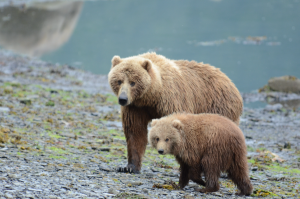Last week I posted about the mechanics of bear hibernation, but how does a large mammal manage to curl up in a ball in a cave and sleep for five months? Humans and other mammals would die if they tried to hibernate. During hibernation, bears do not eat, urinate or defecate. What physiological adaptations allow them to do this?
While in hibernation, a brown bear’s breathing drops from 6 to 10 breaths per minute to one breath every 45 seconds. His heart rate drops from forty to fifty beats per minute to nineteen beats per minute, but his body temperature decreases only a few degrees and does not drop below 88° F (31°C), which is within 12°F (6°C) of his normal body temperature. Some scientists consider bears to be “super hibernators.” Because they have thick fur and also a lower surface area to mass ratio than do smaller hibernators such as rodents, bears lose body heat slowly, which allows them to cut their metabolic rate by 50-60%. Physiologist Øivind Tøien at the University of Alaska Fairbanks has discovered that while a black bear’s body temperature only drops an average of 9.9° F (5.5° C), the bear’s metabolism plunges to 25% of the average summer rate. Furthermore, his studies indicate that when a black bear comes out of hibernation in the spring, it takes several weeks for the bear’s metabolism to return to normal.
The amazing physiological adaptations of bears during hibernation are of much interest to human medical researchers. If a human must endure prolonged bed rest due to paralysis or illness, if a broken limb is immobilized, or if an astronaut spends several months in space; the human body faces such risks as blood clots, heart failure, significant loss of muscle mass, a breakdown of carbohydrates, proteins, and fats, as well as life-threatening bedsores. A hibernating bear has none of these risks, including no loss of muscle function. Scientists are interested in determining what specific changes in metabolites, proteins, and hormones allow bears these physiological adaptations during several months of inactivity. Humans, as well as all other mammals who maintain non-weight-bearing positions for an extended period, suffer from osteoporosis, but bears do not lose bone mass during hibernation. When the secret to how bears accomplish this feat is discovered, it may help people with weak bones, patients who become bedridden for a prolonged period, people who suffer paralysis, and astronauts on long space missions.
While bears are hibernating and metabolizing body fat, their cholesterol levels are twice as high as respective cholesterol levels in humans. Bears, however, do not suffer from arteriosclerosis or gallstones, conditions which plague humans with high cholesterol. Furthermore, a bear’s liver secretes a substance that dissolves gallstones in humans. Insight into how bears recycle urea during hibernation could lead to advances in treatments for kidney failure and dialysis in humans. Also, bears gain a great deal of weight in the fall before going into hibernation, but unlike many obese humans, they remain insulin-sensitive. Conversely, they become insulin-resistant once they are in hibernation, so their fat does not break down too quickly, but when they wake in the spring, they once again respond to insulin. In other words, bears can put themselves into a diabetic state while in hibernation and then reverse out of it in the spring. Understanding what allows bears to do this could lead to breakthrough medical advances in the treatment of diabetes and obesity in humans.
There’s so much more going on with hibernation than simply curling up for a long winter’s nap. I look forward to reading new scientific studies on bear hibernation.
Sign up for my Mystery Newsletter if you haven’t already done so. Next month I plan to cover some Kodiak murders.























